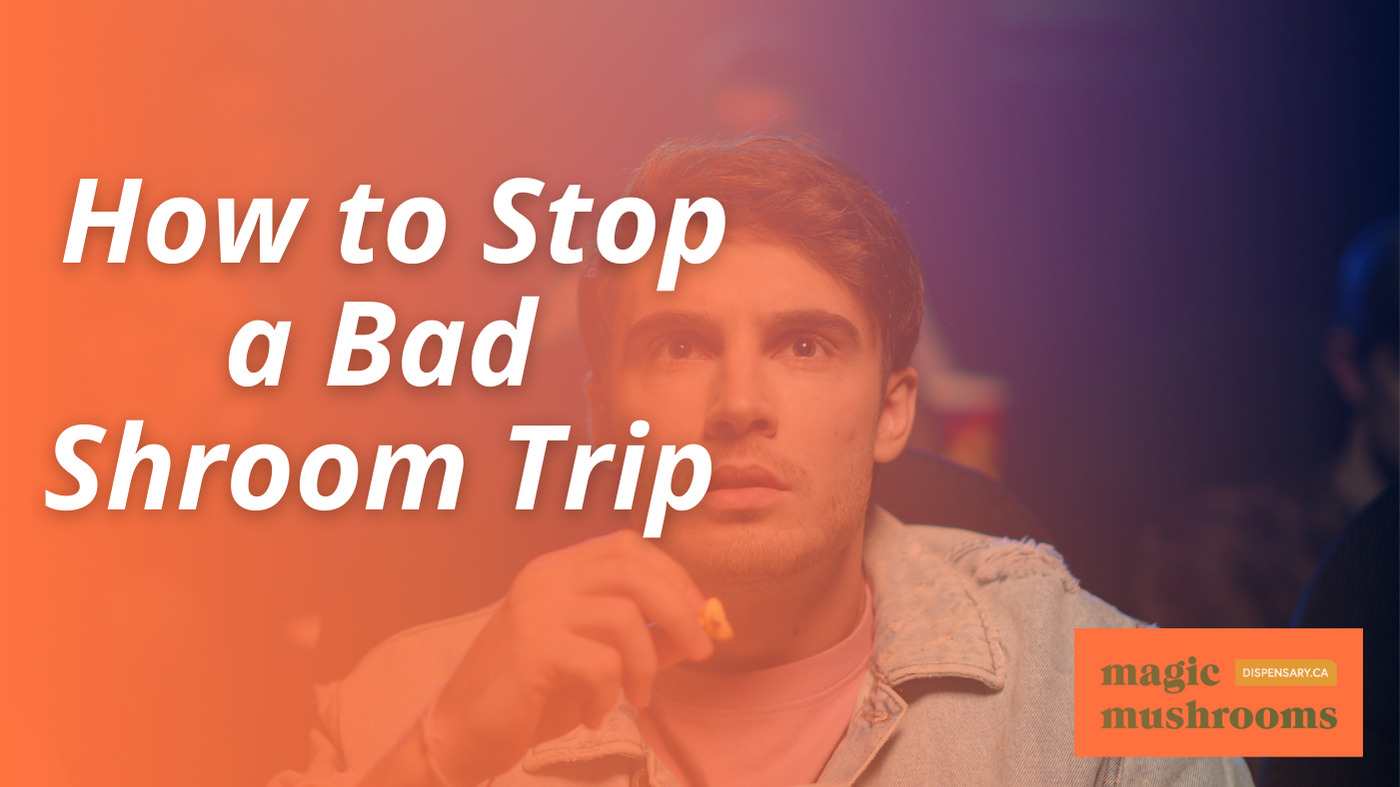When venturing into the use of psilocybin mushrooms, novices might not be adequately ready to handle a difficult experience, commonly referred to as a ‘bad trip.’ These unexpected events can provoke a range of adverse feelings and perceptions, underscoring the importance for individuals to have the necessary knowledge and approaches to navigate these instances competently. This manual provides critical methods and understandings to protect the user’s psychological and emotional health.
We invite the seeker to uncover methods to pivot a challenging experience towards a more controlled and possibly insightful journey by initiating a discussion on practical interventions and the significance of setting, companionship, and mental grounding. The importance of these strategies cannot be overstated, as they not only offer immediate relief but also contribute to the long-term perspective of psychedelic use.
Key Takeaways
- Have a trusted friend or sitter present to provide emotional support and reassurance.
- Change the environment or use distractions like music and soft lighting to positively alter the trip’s trajectory.
- Utilize grounding techniques, such as deep breathing or engaging the senses, to reconnect with reality and reduce trip intensity.
- Ensure hydration and consider guided meditation or positive affirmations to calm the mind and regain control.
Recognizing a Bad Trip
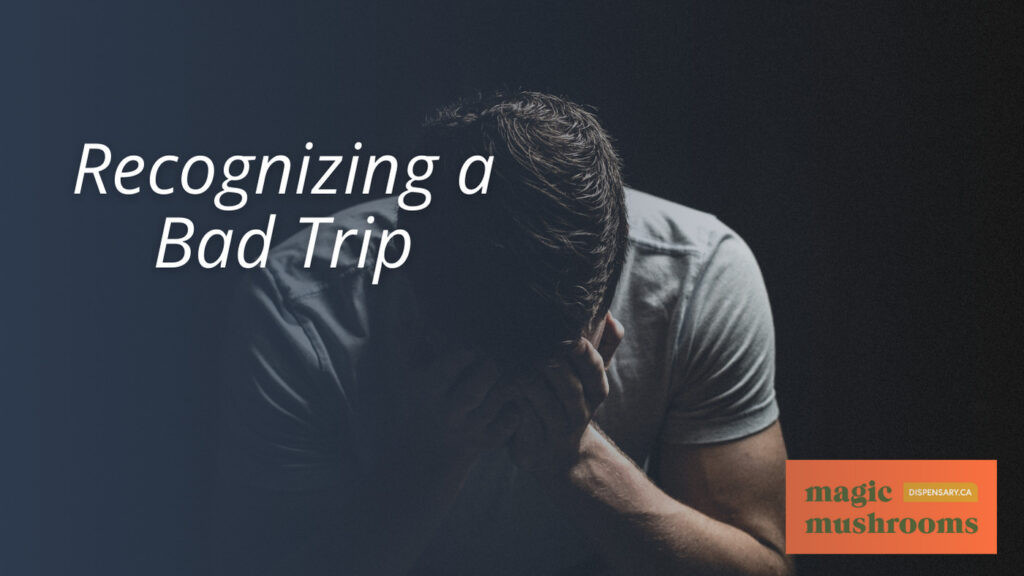
Understanding the signs of a bad trip, which often manifest as panic, terrifying thoughts, and an overwhelming sense of anxiety, is essential for effectively managing the experience. These distressing symptoms can resemble heightened anxiety attacks or even paranoid psychosis, making it critical to recognize them early. Knowing how to stop a bad shroom trip or how to stop a bad mushroom trip starts with this recognition. The unpredictable nature of psychedelic experiences means that difficulty in recognizing a lousy trip is common, but awareness of the potential signs can be a first step in mitigation.
Classic hallucinogens, dissociative drugs, marijuana, and MDMA are among the substances known to induce bad trips potentially. Individuals may experience fear of losing control, dying, or succumbing to an endless loop of negative thoughts. These symptoms underscore the importance of having strategies in place for those seeking to explore the psychological effects of these substances safely.
Recognizing a bad trip is more than just about identifying the signs; it’s about understanding the context in which these substances are used and the user’s psychological state. The presence of a trusted friend or sitter during the trip can offer reassurance and support, making it easier to manage a lousy trip effectively. Immediate action, such as changing the environment or focusing on positive affirmations, can also play a critical role in shifting the experience towards a more positive direction. Remember, bad trips are temporary, and understanding their signs is the first step toward ensuring a safer exploratory experience.
Stay Calm and Breathe
Amidst a lousy shroom trip, focusing on slow, deep breaths can significantly aid in regaining composure and alleviating anxiety. Controlled breathing is a powerful and accessible tool that can substantially impact one’s emotional state. By consciously taking deep breaths, individuals can help regulate their heart rate, which often becomes erratic during stressful experiences. This physiological response can, in turn, promote a calming effect on the mind, reducing feelings of panic and anxiety.
Deep breathing exercises offer more than just immediate relief; they also provide a focal point that can distract from overwhelming sensations and thoughts. By shifting attention to the rhythm of one’s breath, there is an opportunity to move away from negative patterns of thinking that can exacerbate a bad trip. This technique encourages a mindfulness approach, where focusing on the present moment helps manage the intensity of the experience.
Additionally, deep breathing can instill a sense of control and stability during a time when one might feel caught in a tumultuous psychological state. It serves as a reminder that despite the chaos of a challenging trip, there are measures that can be taken to navigate through it more effectively. Engaging in mindful breathing exercises not only assists in grounding oneself but also reinforces the understanding that this difficult experience is temporary and manageable.
The Importance of Setting
The setting, encompassing both the physical and social environment, plays a pivotal role in shaping the experience of consuming magic mushrooms, potentially mitigating the occurrence of a bad trip. The significance of the setting cannot be overstated, as it directly influences the sensory and emotional journey that individuals begin upon while under the influence of psilocybin, the psychoactive compound found in magic mushrooms. Factors such as lighting, noise levels, comfort, and familiarity with one’s surroundings contribute to the overall mood and mindset, which are critical in determining the trajectory of a mushroom trip.
A favorable setting, characterized by a calm, comfortable, and familiar environment, can significantly enhance the mushroom experience. Such settings help individuals feel more at ease, minimizing stressors that could potentially trigger anxiety or negative emotions during the trip. Adjusting the lighting to a comfortable level, ensuring a quiet or pleasing auditory background, and being in a space that feels safe and welcoming can make a substantial difference in the quality of the experience.
Additionally, the social aspect of the setting also holds significance. The presence of a trusted friend or sitter can provide an additional layer of comfort and security, offering reassurance and support if needed. This social support can be invaluable, especially for individuals who may find themselves struggling with challenging thoughts or feelings during their experience.
Creating a Safe Space
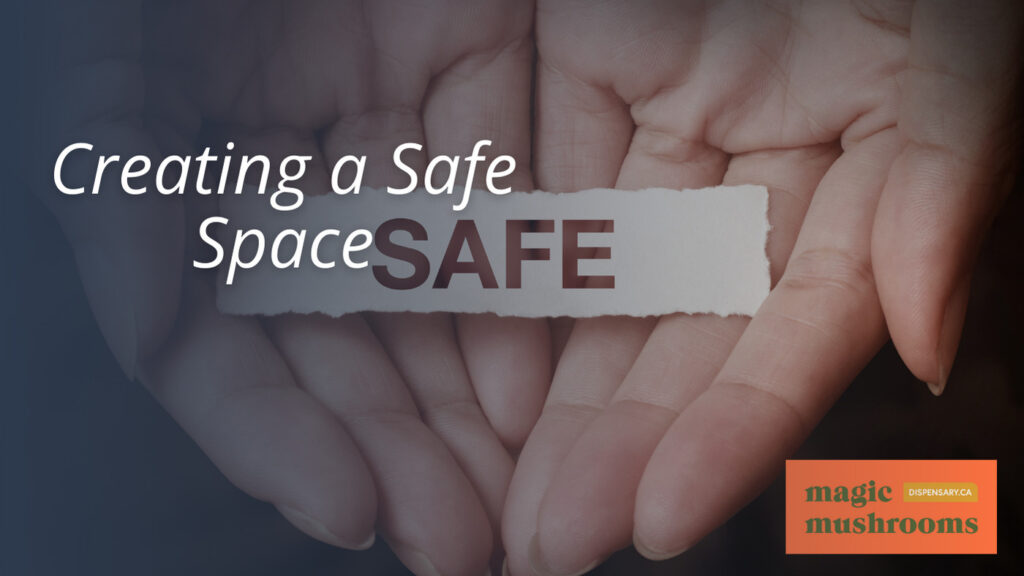
Recognizing the significance of setting in shaping a positive psilocybin experience, it becomes equally important to focus on creating a safe space that minimizes external stressors and enhances comfort during a lousy shroom trip. A meticulously prepared environment can mitigate the intensity of a challenging psychedelic journey, fostering a sense of security and peace.
Creating such a safe space involves several vital elements. First, ensuring the environment is comfortable, quiet, and familiar is paramount. This familiarity can provide a psychological anchor, reducing disorientation and fear. Dimming the lights and playing soft, calming music can further soothe the senses, cultivating an atmosphere conducive to relaxation and introspection. Equally, the availability of soft blankets or pillows can offer physical comfort, adding to the overall feeling of well-being.
Safety is another critical aspect. Removing sharp objects, potential hazards, or any items that could trigger negative emotions is essential to prevent accidents and minimize anxiety. This proactive approach addresses physical and psychological safety, ensuring the individual feels secure throughout their experience.
Additionally, the presence of a trusted friend or sitter must be balanced. If needed, this person can provide emotional support, reassurance, and practical assistance as a stabilizing force during moments of distress.
Use Grounding Techniques
Utilizing grounding techniques is essential for reconnecting with reality and mitigating the intensity of a bad shroom trip. These techniques engage the senses, providing an immediate focus on the present moment, which can be especially beneficial when the mind is caught in the throes of a challenging psychedelic experience. By anchoring the senses to tangible experiences, individuals can find relief from overwhelming emotions and thoughts, guiding them gently back to a sense of normalcy.
One effective grounding method involves tactile sensations, such as taking a shower. The sensation of water on the skin can serve as a powerful reminder of the physical world, starkly contrasting the distorted perceptions induced by the shrooms. Similarly, holding an ice cube can provide a sharp yet safe sensory input that demands attention and diverts focus from distressing hallucinations or thought patterns.
Incorporating taste as a grounding technique, eating certain foods like salt and vinegar chips not only provides a distraction but also stimulates the senses in a familiar and comforting way. This can help shift the individual’s focus from internal turmoil to the simple act of eating, fostering a sense of normality.
Aromatherapy offers another layer of grounding through olfactory stimulation. Essential oils such as lavender or peppermint can elicit calmness and comfort, reducing anxiety. The familiar and soothing scents can serve as a lifeline, pulling the individual back from the precipice of panic.
Lastly, auditory stimuli, such as calming music or ambient sounds, can also play a significant role in grounding. These sounds can create a serene atmosphere, enveloping the individual in a cocoon of safety and tranquility, further aiding in their return to equilibrium.
Changing Your Environment
Altering one’s surroundings during a challenging shroom experience can significantly influence the trajectory of the trip, guiding it away from distress and towards a more manageable state. The environment plays a critical role in shaping the psychedelic experience. When negative thoughts and feelings spiral, a change of scenery can act as a circuit breaker, disrupting the feedback loop that fuels a lousy trip.
Moving to a safe, familiar space is often the first step in changing one’s environment. This could mean retreating to a cozy room or breathing fresh air outside. Such spaces can provide comfort and a sense of security, essential elements when steering the turbulent waters of a challenging experience. The familiarity breeds a sense of normalcy and control, which is often lost during a bad trip.
Bright lights and loud noises can exacerbate anxiety and confusion during a psychedelic experience. It is important to find a setting that minimizes these sensory inputs. A dimly lit room or a quiet natural setting can help calm the mind, facilitating a more serene mental state. Surrounding oneself with familiar and comforting items, such as blankets or personal mementos, can also enhance this effect, promoting relaxation and safety.
The Power of Distraction
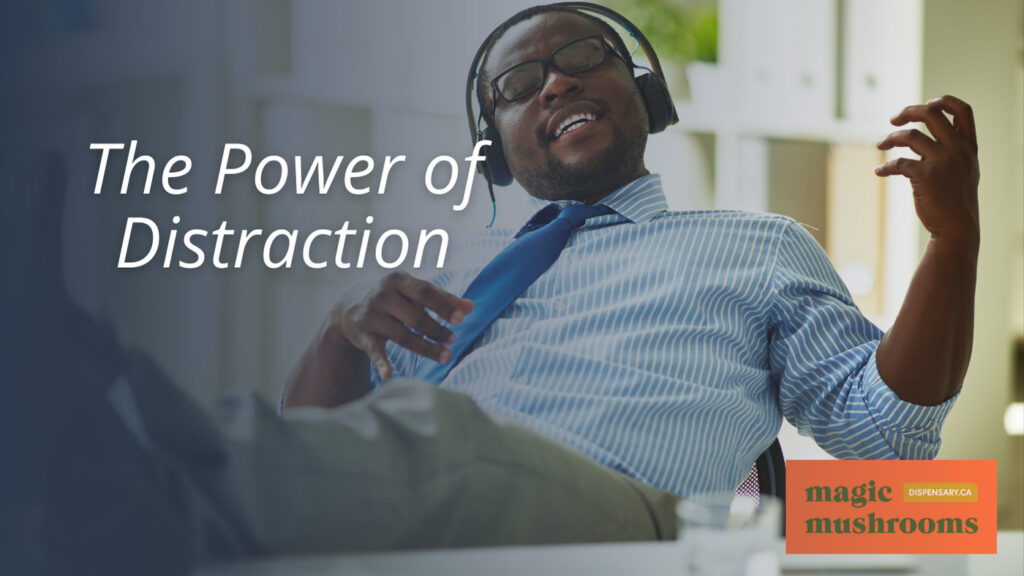
Moving beyond the immediate environment, another effective strategy for mitigating a lousy shroom trip involves deliberately using distraction techniques. These methods are grounded in the principle of redirecting the focus away from negative thoughts and emotions, which are often magnified during a psychedelic experience. By engaging the mind and senses in alternative stimuli, individuals can effectively alter their current state of mind, potentially steering the trip toward a more positive direction.
Activities such as drawing or engaging in other forms of creative expression can serve as powerful tools for distraction. These activities occupy the mind and allow for the expression of the trip’s intensity constructively. Similarly, immersing oneself in nature through a gentle walk or simply sitting in a serene environment can shift perspective and provide a calming effect. The natural world offers many sensory experiences that can captivate attention and foster a sense of connection and well-being.
Modifying one’s immediate surroundings can also significantly alter the trip’s trajectory. Simple changes in lighting, for instance, can create a new ambiance that feels safer and more comforting. Additionally, visually stimulating activities, such as watching certain types of movies, can provide a welcome escape and help redirect the mind’s focus.
Utilizing positive affirmations or mantras is another distraction technique that can influence one’s emotional state. Repeating these affirmations can help cultivate a more positive internal dialogue, counteracting the negative thoughts often accompanying a lousy trip. By consciously focusing on positive messages, individuals can navigate the challenging experience with a sense of control and optimism.
Music and Its Influence
The therapeutic potential of music cannot be overstated in mitigating a lousy shroom trip, as its soothing melodies and gentle rhythms can greatly influence emotional and mental states. Music’s power to shift focus away from negative thoughts and create a positive atmosphere is a valuable tool in the arsenal against uncomfortable psychedelic experiences. Research and anecdotal evidence highlight how specific music frequencies and sounds can profoundly impact our emotions and mental well-being, suggesting a direct link between auditory stimuli and psychological states.
Notably, music characterized by calming melodies and gentle rhythms can foster an environment conducive to relaxation and anxiety reduction. Ambient music, including nature sounds or soft instrumental tracks, has been shown to aid in creating a serene setting, which can be particularly beneficial during the unsettling moments of a bad shroom trip. The choice of such music can help steer the mind away from distressing thoughts and towards a more peaceful mental landscape.
Additionally, using headphones to listen to music during a psychedelic experience can offer a more immersive and personal listening experience, enhancing the calming effects of the music. This method allows individuals to envelop themselves in a cocoon of soothing sounds, further distancing themselves from the triggers of their discomfort. Thus, the strategic selection and use of music during a lousy shroom trip can play an essential role in transforming the experience into one that is more manageable and ultimately more positive.
Engaging in Mindful Activities
Engaging in mindful activities has proven effective for individuals seeking to manage the effects of a challenging shroom trip. These practices focus on calming the mind and shifting attention away from distressing experiences. Deep breathing exercises are a cornerstone of this approach, providing an immediate method to promote relaxation and reduce anxiety. By concentrating on slow, measured breaths, individuals can anchor themselves in the present moment, distancing their consciousness from overwhelming psychedelic effects.
Practicing grounding techniques such as meditation or yoga further enhances this sense of present-moment awareness. These activities offer a structured way to reconnect with the body and environment, helping to alleviate the disorientation and distress that can accompany a challenging psychedelic experience. They serve as a distraction and a pathway to inner calm and stability.
In addition to these practices, engaging in creative activities like drawing or listening to soothing music can offer a significant diversion from negative thoughts and emotions. These activities stimulate the senses in a gentle, non-invasive manner, providing a comforting distraction that can help shift the mood and perspective of the individual experiencing a challenging trip.
Utilizing sensory stimulation, such as aromatherapy or calming sounds, can further create a soothing environment conducive to managing through an arduous psychedelic journey. The gentle engagement of the senses with pleasant stimuli can effectively counterbalance the sensory overload often experienced during a challenging shroom trip, offering a gentle guide back to a state of calm and collectedness.
The Role of a Trip Sitter
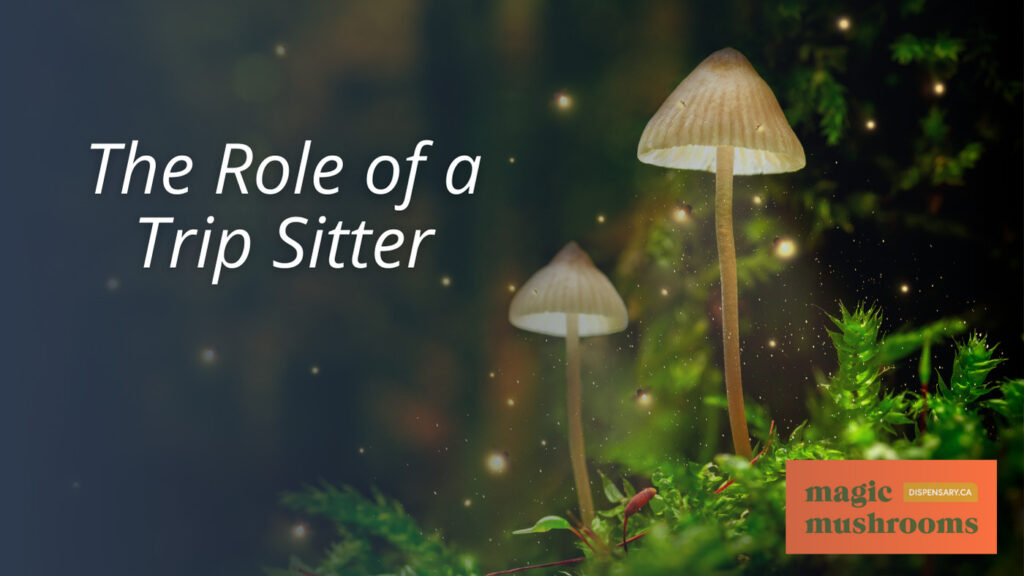
While mindful activities offer a method to manage the effects of a challenging shroom trip, the presence and support of a trip sitter can significantly enhance the safety and well-being of the individual undergoing this experience. A trip sitter is a sober companion whose primary role is to provide support, guidance, and supervision during a psychedelic journey, guaranteeing the tripper’s safety and emotional well-being. This role is vital during adverse experiences, commonly referred to as ‘bad trips,’ where the individual may encounter heightened anxiety, fear, or confusion.
The trip sitter’s responsibilities extend beyond mere presence. They are tasked with creating and maintaining a calm, safe environment that promotes positivity and comfort. Their ability to remain grounded and composed can have a stabilizing effect on the individual experiencing distress. By offering reassurance and a rational perspective, trip sitters can help mitigate the intensity of a bad trip, guiding the individual back to a more manageable state of mind.
Furthermore, the trip sitter is a precaution against potential accidents or harmful behaviors by closely monitoring the individual’s condition and intervening when necessary. Their preparedness to handle challenging situations is crucial, as it not only guarantees the immediate safety of the person tripping but also contributes to a more secure and controlled setting for the psychedelic experience.
The presence of a trip sitter plays a pivotal role in managing the complexities of a shroom trip, providing an indispensable layer of security and support that enhances the overall experience.
Hydration and Light Snacks
Maintaining hydration and consuming light snacks are essential in alleviating physical discomfort and stabilizing the mood during a challenging shroom trip. During such experiences, the body can undergo a range of physical and emotional stresses that, if not managed properly, may exacerbate the situation. It is critical, thus, to pay attention to the body’s needs, starting with hydration and nutrition, to navigate the trip more comfortably.
Staying hydrated is essential for maintaining normal body functions and can help alleviate some physical discomforts that may arise during a lousy shroom trip. Water is the best option for staying hydrated, but herbal teas can also be soothing and provide a comforting warmth without the stimulating effects of caffeine. Proper hydration supports the body’s natural processes and can contribute to a sense of well-being, even in the midst of a challenging experience.
In addition to hydration, consuming light snacks can provide a gentle energy boost and help regulate blood sugar levels, which can influence mood stability. Foods that are easy to digest, such as fruits or simple crackers, are ideal. These foods provide essential nutrients without overburdening the digestive system, which might already be sensitive due to the psychedelic experience. Avoiding heavy, greasy, or overly sugary foods is necessary, as these can worsen nausea or lead to discomfort.
Avoiding Negative Stimuli
After addressing the importance of hydration and light snacks, it is also necessary to contemplate the role of the environment in mitigating the effects of a lousy shroom trip, specifically by avoiding negative stimuli. Negative stimuli, such as loud noises, bright lights, and chaotic environments, can significantly amplify feelings of anxiety and fear during a shroom trip. These elements can transform an already challenging experience into a profoundly distressing ordeal. Creating a setting that minimizes these triggers is critical for maintaining a calmer mind.
To counteract the potential for a negative experience, it’s recommended to immerse oneself in a soothing atmosphere. This can be achieved by calming music, dimming the lights, and ensuring the surroundings are comfortable and familiar. Such an environment can help shift the focus away from distressing stimuli and foster a sense of safety and tranquility.
Moreover, relaxing activities like deep breathing, meditation, or gentle movement can be practical tools for redirecting attention from negative thoughts and emotions. These practices soothe the mind and promote a more positive and controlled trip experience.
To wrap up, the presence of supportive and understanding individuals cannot be overstated. A trusted friend or sitter can provide invaluable reassurance and comfort. Their ability to empathize and offer calm guidance can be a cornerstone in steering through the tumultuous waves of a lousy shroom trip, ensuring the journey leads towards a more serene destination.
Positive Affirmations
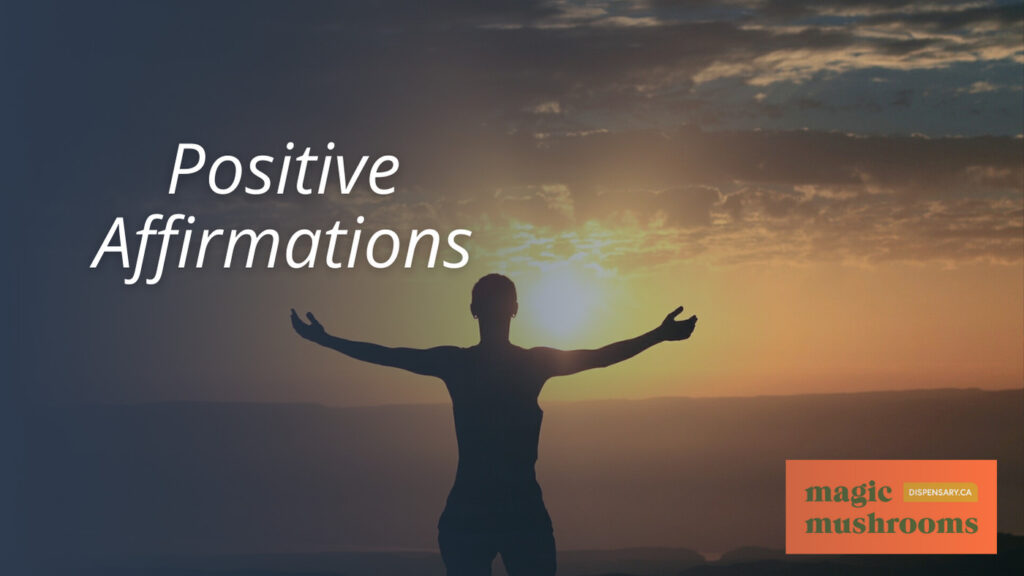
Harnessing the power of positive affirmations can significantly mitigate the distressing effects of a lousy shroom trip by guiding the mind toward a more tranquil and secure state. Positive affirmations serve as mental anchors, offering comfort and reassurance by reminding individuals of their inner strength and resilience. This mental strategy can be particularly effective in shifting the focus from negative thoughts and fears to a more optimistic outlook.
When caught in the throes of a challenging psychedelic experience, affirming positive outcomes and focusing on gratitude can immensely alter the trip’s trajectory. Simple yet powerful statements such as ‘I am safe,’ ‘This will pass,’ and ‘I am in control of my mind’ can profoundly impact. These affirmations help cultivate a sense of safety and control, which is often lost during a bad trip. Repeating these uplifting and empowering phrases encourages a shift towards a positive mental space, effectively countering the spiraling negativity.
It is essential to approach these affirmations sincerely and believe in their truth. The effectiveness of positive affirmations lies not just in their repetition but in the genuine acceptance and internalization of their message. By consciously focusing on positive affirmations, individuals can navigate the tumultuous waters of a lousy shroom trip, steering towards calmer shores. This practice underscores the power of the mind in influencing perception and experience, offering a valuable tool for those seeking to reclaim their sense of well-being during challenging psychedelic explorations.
Understanding the Experience
Recognizing the role of positive affirmations in managing a lousy shroom trip, it becomes equally important to understand the multifaceted nature of the experience itself. A bad shroom trip can stem from a complex interplay of internal and external factors. Internally, unresolved issues and subconscious conflicts may surface, manifesting as intense, often unsettling, emotional, and perceptual distortions. Externally, the immediate environment, the company one keeps, and the prevailing mood at the time of ingestion play vital roles. A setting that feels unsafe or uncomfortable or around people emitting negative energies can significantly skew the trip towards a negative experience.
Proper preparation is paramount in mitigating the risk of a bad trip. This includes selecting a safe and comforting environment, being mindful of the dose and the variety of mushrooms consumed, and ideally, having a trusted friend or ‘trip sitter’ present. These preparatory steps can create a foundation of safety and reassurance.
Moreover, understanding that a bad trip is temporary can be a source of comfort during the experience. It is also important to acknowledge the potential for psychological growth that can emerge from confronting and navigating through the challenging aspects of a trip. Calming techniques and strategic changes to external stimuli can steer the experience toward a more manageable or insightful direction. Recognizing and respecting the power and unpredictability of psilocybin is vital in steering and ultimately learning from the experience.
Guided Meditation Practices
Guided meditation emerges as a powerful tool for mitigating the distress and anxiety often associated with lousy shroom trips, offering a pathway to tranquility and mental clarity. This practice involves a structured approach, where individuals are led through mental exercises focusing on breathing, body sensations, and positive affirmations. The goal is to shift the mental state from panic and disarray to calm and order.
Research supports the effectiveness of guided meditation in reducing stress, enhancing mood, and promoting relaxation. These outcomes are particularly relevant during the challenging moments of a lousy shroom trip, where the mind can become a battleground of negative thoughts and fears. By directing attention to the present moment and engaging in mindful observation of the breath and body, individuals can anchor themselves in reality, distancing themselves from the distressing hallucinations or thought patterns triggered by the psychedelic experience.
Guided meditation practices can be accessed through various online platforms or apps, providing users with a wealth of structured sessions designed to help them navigate difficult emotional landscapes. These resources often include a range of sessions tailored to different needs, from short, calming exercises to longer, more immersive meditations aimed at deep psychological healing.
Regular engagement with guided meditation can also build resilience and coping skills, equipping individuals with the mental tools necessary to navigate future psychedelic experiences with greater ease and confidence. Ultimately, guided meditation offers immediate relief during a lousy shroom trip and contributes to long-term psychological well-being.
The Benefits of Fresh Air
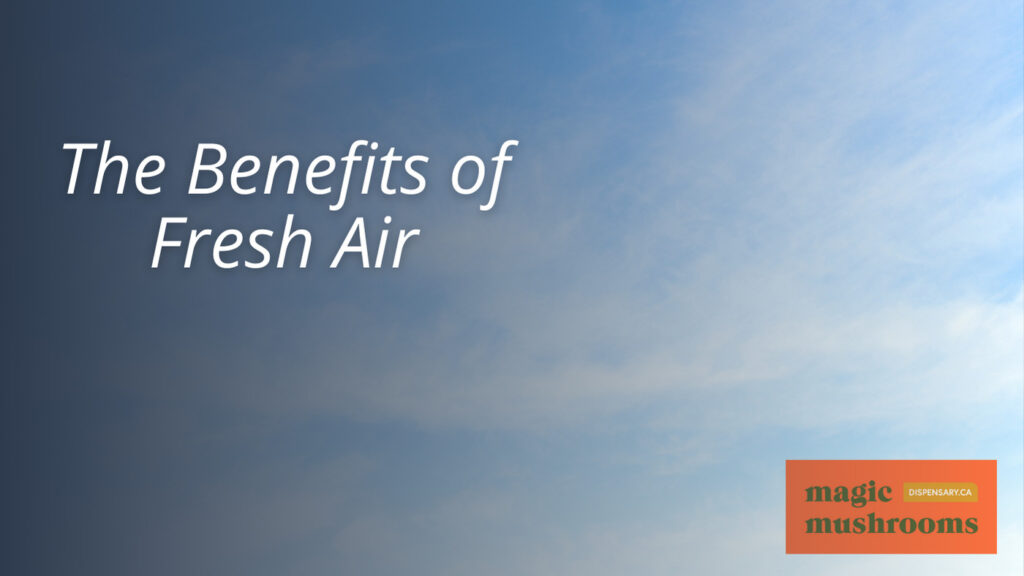
Building on the foundation of guided meditation, the benefits of fresh air introduce another effective strategy for managing a bad shroom trip. Encountering a challenging experience while under the influence of psilocybin, more commonly known as shrooms, can be overwhelming. However, the simple act of stepping into a fresh, open environment can significantly alter the trajectory of the experience. Fresh air into the system acts as a natural tranquilizer, helping to clear the mind and instill a sense of calm that is often desperately needed during such episodes.
Breathing deeply in an outdoor setting not only helps regulate the body’s oxygen levels but also plays a vital role in reducing feelings of anxiety and panic that can accompany a bad trip. The physiological response mirrored the psychological benefits, creating a holistic approach to managing the situation. Additionally, being in nature, with its inherent grounding effects, fosters a connection to the environment that can be profoundly reassuring. This connection can offer a new perspective, helping to alleviate the feelings of claustrophobia or confinement that might have exacerbated the negative experience.
In addition, a change of scenery, achieved by taking a walk or simply sitting in a well-ventilated area, can provide a pivotal shift in mindset. This shift is not insignificant; it can transform a downward spiral into a more manageable and potentially enlightening experience. Therefore, the strategic use of fresh air not only offers immediate relief but also contributes to a longer-term strategy for dealing with challenging psychedelic experiences.
Reaching Out for Support
Amid a challenging shroom trip, reaching out to a trusted friend or family member can significantly alter the course of the experience by providing essential emotional support. This step is critical as it allows the individual experiencing the trip to communicate their feelings and situation, seeking comfort and reassurance during a vulnerable time. The presence of a supportive person not only brings a sense of safety but also helps in maneuvering through the distressing experience with a more evident mindset.
When selecting someone to reach out to, it’s essential to choose an understanding, calm, and preferably sober individual. This guarantees that they can provide the necessary support effectively. Consider asking the person to come over. Their physical presence can have a calming effect, further aiding in alleviating the intensity of the bad trip. Additionally, the sober companion can assist in creating a cozy environment filled with comforting items, which can play a significant role in soothing the individual.
Having someone to talk to during such experiences can help in grounding the individual, reminding them that the effects are temporary and that they are in a safe space. This reassurance can be pivotal in shifting the focus from distressing hallucinations or thoughts to more positive and calming stimuli.
Utilizing Aromatherapy
Harnessing the power of aromatherapy, individuals experiencing a lousy shroom trip can find solace and relaxation through essential oils like lavender and peppermint. These natural remedies are known for their calming and soothing properties, which can be particularly beneficial during the intense and often anxiety-inducing experience of a problematic psychedelic journey.
Aromatherapy works by stimulating the olfactory system, the part of the brain connected to smell. When the scent of essential oils like lavender or peppermint is inhaled, it can trigger a relaxation response in the brain, helping to ease feelings of anxiety and fear. This response can provide a much-needed sense of calm and relaxation, making navigating through the challenging aspects of a bad shroom trip easier.
Additionally, focusing on pleasant and familiar scents can serve as a valuable sensory distraction, helping to shift focus away from negative thoughts and emotions. This redirection of attention can be a powerful tool in altering the course of a bad trip, guiding the individual towards a more positive and manageable experience.
The soothing ambiance of aromatherapy can further enhance the environment, promoting a sense of well-being and security. By grounding and centering oneself with the help of these essential oils, individuals can reduce the intensity of their bad trip, making it more bearable and straightforward to overcome.
Art and Creative Outlets
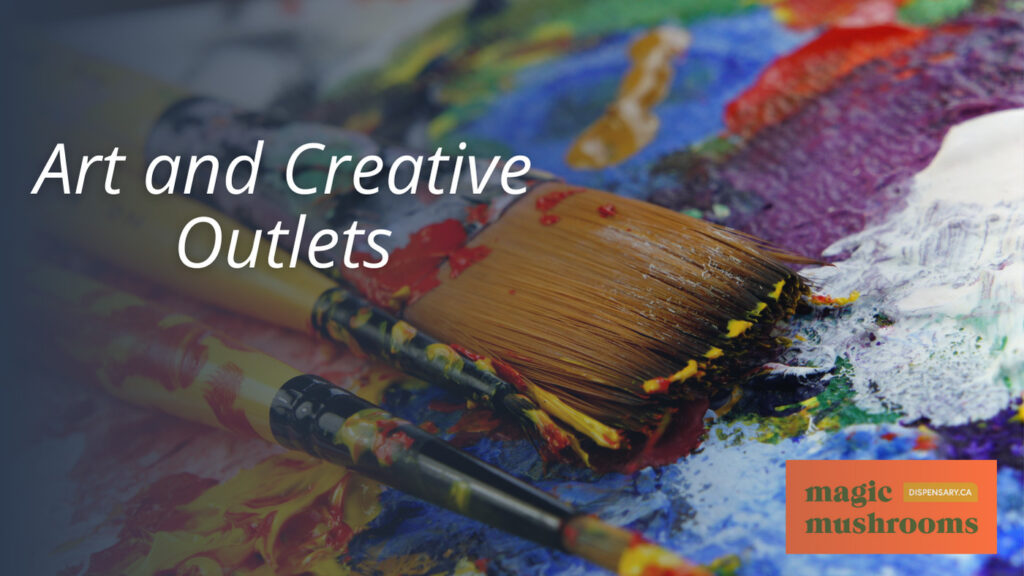
Turning to art and creative outlets offers a transformative escape for individuals maneuvering the tumultuous waters of a bad shroom trip. Engaging in artistic activities such as drawing, painting, or crafting serves as a distraction and a powerful tool for emotional expression and self-discovery. These creative pursuits allow individuals to channel their negative energies and anxieties into something tangible and cheerful, providing a unique form of release and relief.
Artistic expression during such a challenging experience can significantly reduce feelings of anxiety and promote a sense of calm and peace. By focusing on the act of creating, individuals may find themselves less consumed by the distressing sensations and thoughts that characterize a terrible trip. Additionally, making art encourages introspection and can facilitate a more profound emotional release, offering insights into one’s inner self and emotions.
The therapeutic benefits of art during a lousy shroom trip cannot be understated. It offers a cathartic experience that not only aids in coping with the immediate discomfort but also promotes personal growth and understanding. Creating something from one’s imagination can foster a connection to the inner self that is both healing and enlightening.
Watching Comforting Visuals
One effective strategy to mitigate the effects of a lousy shroom trip involves watching comforting visuals, such as serene nature scenes or gentle animations, which can significantly alter one’s mood and perception. This method leverages visual stimuli’s profound impact on our emotional state, particularly during heightened periods of sensitivity like those experienced during a shroom trip. Individuals can find a much-needed sense of peace and distraction by redirecting focus away from distressing thoughts or feelings and towards calming and uplifting images.
Visual content such as calming nature scenes, soothing animations, or positive affirmations can be a gentle buffer against overwhelming experiences. This type of content can provide a distraction and a reminder of the beauty and positivity in the world, helping to shift the trip in a more positive direction. Engaging with visually appealing content has the potential to significantly reduce anxiety, fostering a more pleasant and controlled psychedelic experience.
To maximize the benefits of this strategy, individuals might consider preparing a playlist of comforting videos or images in advance. This foresight guarantees that such content is readily available when needed, allowing for a smoother change away from negative experiences. The therapeutic value of visual stimuli has been recognized in various settings to promote relaxation and enhance overall well-being, making it a valuable tool for those looking to effectively manage the effects of a lousy shroom trip.
The Significance of Lighting
Building on the discussion of visual comfort, proper lighting emerges as another pivotal factor in managing the atmosphere of a shroom trip. The ambiance created by lighting is not merely a backdrop but an active participant in the journey. It wields the power to soothe or disturb, making its management critical for those seeking to navigate or halt a challenging psychedelic experience.
Research and anecdotal evidence converge on the consensus that soft, warm lighting can significantly mitigate the intensity of a bad trip, fostering a sense of safety and comfort. This type of lighting mimics the natural hues of sunset, which inherently signals relaxation and prepares the body for rest. It contrasts sharply with harsh, bright lighting, often found in clinical or stark environments, which can exacerbate feelings of anxiety or unease. Such lighting conditions can sharpen the edges of a bad trip, making negative emotions and sensations more acute.
Additionally, dim lighting facilitates a deeper, more reflective state. It allows individuals to turn their focus inward, potentially finding calm within the storm of their experience. This introspective potential is further enhanced through the strategic use of colored lights or candles. These can introduce a visual element of wonder and novelty, gently guiding the mind away from distressing thoughts and towards a more meditative or reflective state.
Techniques for Emotional Release
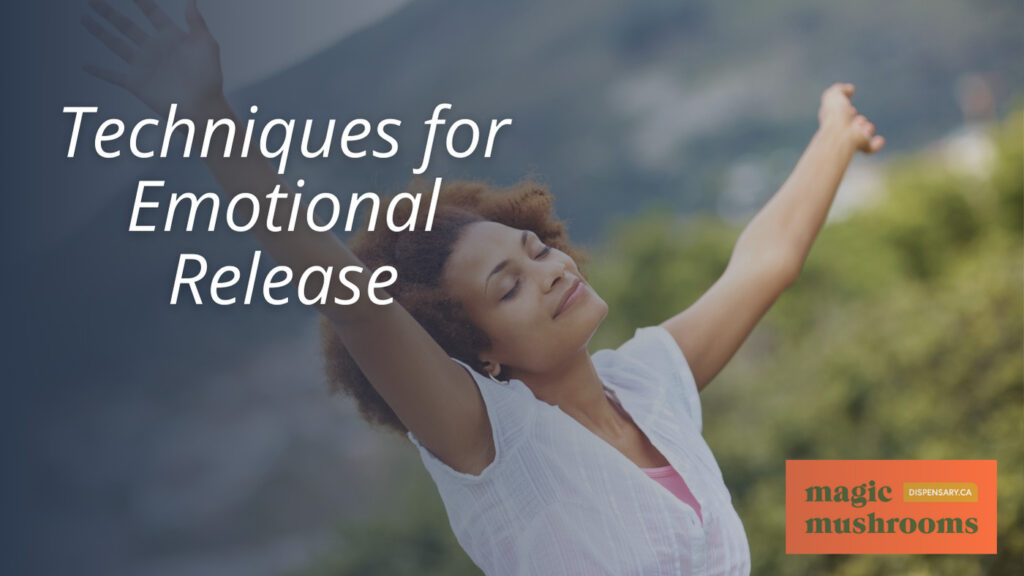
Exploring various techniques for emotional release can be pivotal in traversing the turbulent waters of a bad shroom trip. Experiences of heightened emotional distress are not uncommon during such episodes, and finding ways to navigate these overwhelming feelings is essential for recovery and grounding.
Among the most effective strategies for emotional release is the practice of deep breathing exercises. This method facilitates calming the mind by releasing pent-up emotions, serving as a foundational technique for individuals seeking solace amidst the chaos of a bad trip. Additionally, engaging in expressive activities such as drawing, writing, or talking can greatly aid emotional release and processing. These activities offer a constructive outlet for the myriad of emotions and thoughts that may surface, providing a tangible means of expression and reflection.
Additionally, the auditory environment plays a significant role in shaping one’s emotional state. Listening to soothing music or nature sounds can create a serene atmosphere conducive to emotional release. This auditory stimulation can be particularly effective in fostering calm and tranquility, further aiding emotional release.
Another valuable technique involves practicing mindfulness, including grounding exercises. Such practices help center an individual’s emotions and thoughts, offering a path toward regaining control and stability. Finally, allowing oneself to cry or express emotions freely without judgment is essential. This natural form of emotional release can reduce distress, paving the way for a more manageable and healing experience during a bad shroom trip.
Resetting With Sleep
After examining techniques for emotional release during a lousy shroom trip, it is also beneficial to contemplate the role of sleep in resetting the mind and body. Sleep serves as a powerful tool for recovery, leveraging the body’s natural healing processes to mitigate the effects of a challenging psychedelic experience. By allowing oneself to rest and enter the deep stages of sleep, the brain can begin to process and integrate the intense experiences encountered during the trip. This period of restorative sleep is vital for returning to a state of normalcy, reducing the psychedelic effects that may still linger.
Achieving adequate sleep after a bad trip can significantly diminish the intensity of residual feelings, promoting a sense of safety and relaxation. Creating a comfortable and familiar sleep environment is essential, as this can dramatically enhance the quality of rest and aid recovery. The benefits of a good night’s sleep extend beyond merely reducing the immediate effects of a bad trip; it plays a critical role in calming anxiety, alleviating stress, and bolstering overall well-being.
In the aftermath of a challenging psychedelic experience, prioritizing restful sleep is a crucial strategy for re-establishing balance and harmony within the mind and body. This natural reset mechanism can help individuals regain their footing, process their experiences, and emerge from the ordeal with greater resilience and understanding. Incorporating sleep into the recovery plan after a lousy shroom trip is not just beneficial—it’s essential for healing and restoration.
When to Seek Professional Help
In some instances, professional intervention becomes necessary to navigate the challenging waters of a bad shroom trip. While various strategies may help mitigate the immediate discomforts of a negative psychedelic experience, recognizing when to seek professional help is important for ensuring safety and well-being. Persistent feelings of anxiety, panic, or fear during a trip are clear indicators that professional assistance may be needed. These emotions can be overwhelming; without proper intervention, they may escalate or lead to long-term issues.
Consulting a healthcare provider is advisable if an individual has difficulty managing intense hallucinations or persistent negative thoughts. Hallucinations can sometimes be so vivid and disturbing that they significantly disrupt one’s sense of reality, making it difficult to differentiate between what’s real and what’s not. In such cases, professional guidance can provide the necessary support to navigate these experiences safely.
Moreover, if someone feels overwhelmingly disoriented or unable to control their emotions, it signals a need for immediate professional intervention. This level of disorientation can impair judgment and increase the risk of harm. Additionally, contact emergency services if there are any signs of self-harm or dangerous behavior. The safety of the individual and those around them is paramount.
To conclude, individuals with a history of mental health issues should be particularly cautious. If a lousy trip triggers severe psychological distress, reaching out for medical help is essential. Psychedelic experiences can exacerbate pre-existing conditions, and professional care can help manage these complex reactions. Recognizing these signs and acting promptly can make a significant difference in the outcome of a challenging psychedelic experience.
Reflect and Integrate the Experience
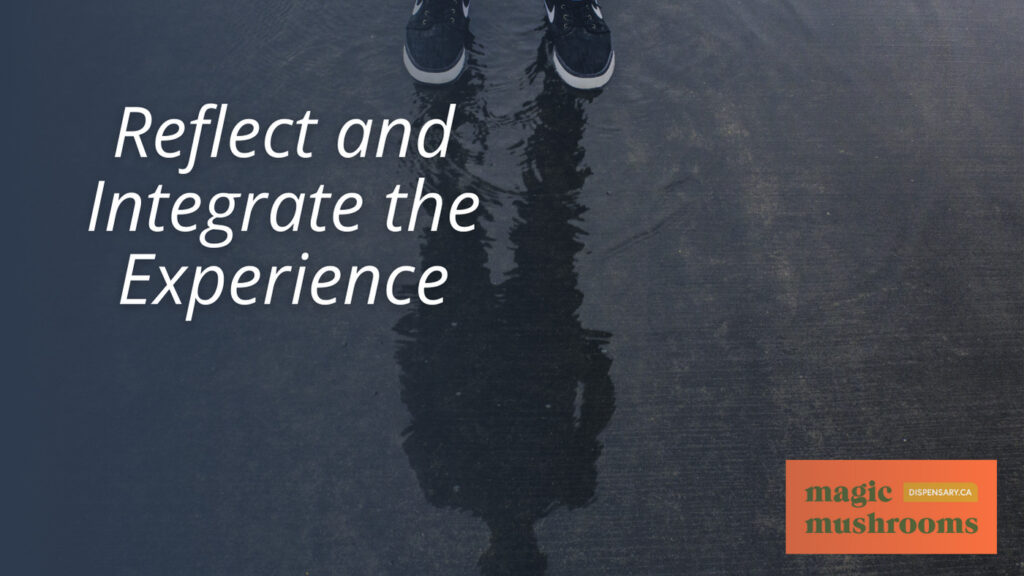
Understanding when to seek professional help during a bad shroom trip is an important step; however, the journey to recovery and growth continues as individuals reflect on and integrate their experiences. This post-trip phase is essential for transforming a potentially traumatic event into a source of personal insight and development. By delving into the emotions, thoughts, and sensations that arose during the trip, individuals can begin to unpack the complex tapestry of their experience.
Reflection allows for identifying patterns, triggers, and underlying issues that may have contributed to the bad trip. It’s an opportunity to confront and process these elements in a safe and controlled environment. Journaling is a powerful tool in this process, offering a means to articulate and explore the nuances of the trip. Writing about the experience can illuminate insights and facilitate a deeper understanding of oneself.
Integration is the next crucial step, where the insights gained from reflection are woven into the fabric of daily life. This might involve adopting new coping mechanisms, shifting perspectives, or changing one’s lifestyle or relationships. Mindfulness practices, such as meditation and yoga, can reinforce this integration, helping ground individuals and promoting inner peace and stability.
For some, the experience’s complexity and the integration challenges necessitate professional guidance. Therapists who specialize in psychedelic integration can offer invaluable support, helping individuals navigate the intricacies of their journey toward healing and growth. This professional support guarantees that the lessons learned from a bad shroom trip are acknowledged and applied in a way that fosters long-term well-being and personal evolution.
Frequently Asked Questions
Can Certain Foods or Supplements Help Shorten the Duration of a Bad Shroom Trip?
Certain foods and supplements may theoretically influence the duration of a psychedelic experience. For instance, foods rich in tryptophan could affect serotonin levels, altering the trip’s intensity. Additionally, supplements like niacin have been purported to shorten the duration of such experiences, though scientific evidence supporting these claims is limited. It is essential to approach this information with caution and consult healthcare professionals before attempting to alter a psychedelic experience through dietary means.
While the Main Sections of the Article Provide Comprehensive Strategies for Coping With a Bad Trip, Readers Might Be Curious if Ingesting Specific Foods, Vitamins, or Supplements Could Potentially Alter the Trip’s Intensity or Duration.
Addressing the inquiry about whether consuming certain foods, vitamins, or supplements can modify a psychedelic experience’s intensity or duration, it is crucial to emphasize that limited scientific research exists on this topic. However, anecdotal evidence suggests that substances like vitamin C or foods rich in tryptophan might influence the trip’s nature. Professional guidance is recommended before attempting to alter a psychedelic experience through nutritional means, as individual responses can vary greatly.
Is It Possible to Build a Tolerance to Psilocybin, Affecting How One Experiences a Bad Trip?
It is a common misconception that one cannot build a tolerance to psilocybin, the psychoactive component in ‘magic mushrooms.’ However, repeated and frequent use can lead to tolerance, which may affect the intensity and nature of experiences, including bad trips. This tolerance necessitates larger doses to achieve the same effects, potentially increasing the risk of adverse reactions. It’s essential to approach psilocybin use with awareness and respect for its potent effects.
This Question Explores the Idea of Psilocybin Tolerance and whether Regular Users Might Experience Bad Trips Differently or find traditional coping mechanisms less effective over time.
The inquiry explores the concept of psilocybin tolerance and its impact on the frequency and intensity of adverse psychedelic experiences. It raises the question of whether chronic users may perceive these episodes differently, potentially diminishing the effectiveness of conventional coping strategies. Understanding the mechanisms of tolerance is vital for evaluating how it influences the psychological effects of psilocybin, including the ability to navigate and mitigate challenging trips.
How Does One’s Mental Health History Impact the Likelihood of Experiencing a Bad Trip?
Individuals with a history of mental health issues, such as anxiety or depression, may have a heightened risk of experiencing a bad shroom trip. For example, a person with pre-existing anxiety might find their symptoms exacerbated during the journey, leading to a more intense and possibly harmful experience. It’s essential to contemplate one’s mental health status before engaging with psilocybin, as it can significantly influence the outcome of the psychedelic experience.
Conclusion
To conclude, traversing the turbulent waters of an adverse mycological voyage requires a blend of self-awareness, environmental modification, and the employment of grounding and calming strategies. The stormy seas can be quelled, transforming a potentially harrowing journey into a voyage of self-discovery and growth. It is important to remember that even the most challenging expeditions are temporary and can lead to profound insights and personal evolution with the right tools and support in place.
Buying Microdosing Mushrooms Online in Canada
Are you an avid microdoser or looking to venture into the art of microdosing? Working with a reliable, trustworthy shrooms dispensary is paramount in your journey of becoming a better version of yourself. Magic Mushroom Dispensary prides itself on its comprehensive collection of top-notch microdosing products, psilocybin books, excellent customer service, and fast, discreet shipping. Visit our online shop today and enjoy low prices and free shipping for orders above $99.
Originally posted on March 19, 2024 @ 5:21 pm

